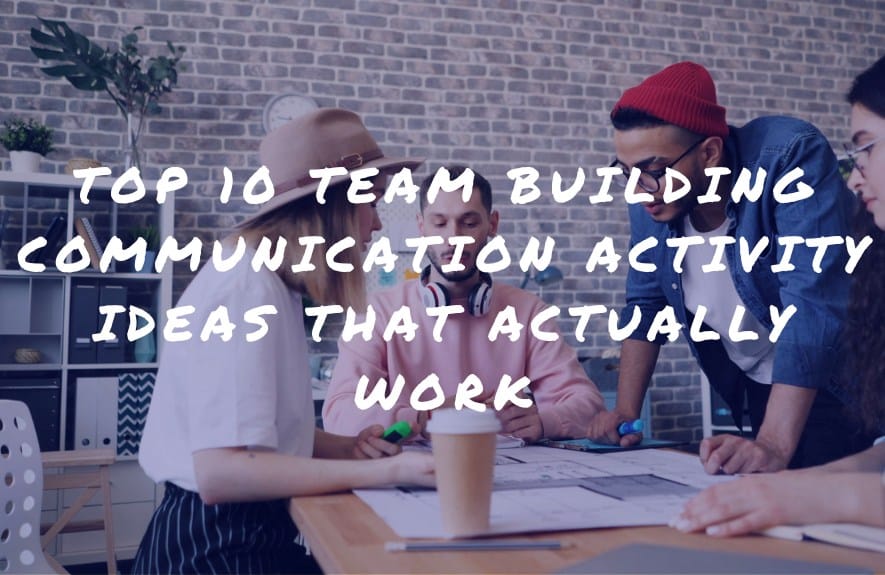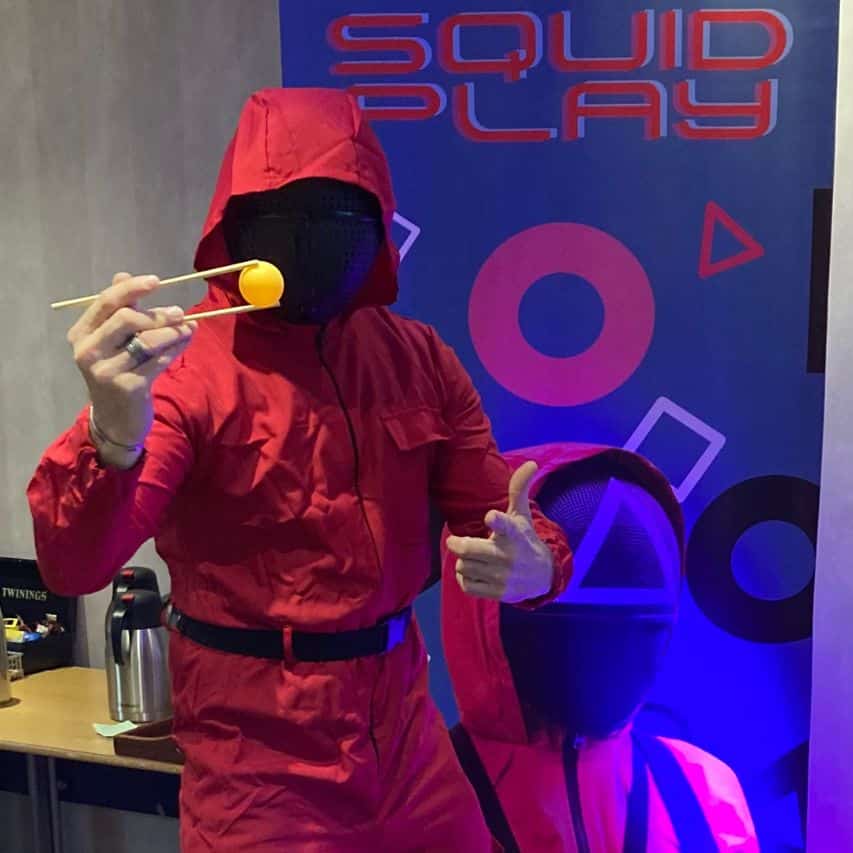Top 10 Team Building Communication Activity Ideas That Actually Work
If you’re reading this, you’ve probably been handed the job of organising a team building communication activity for your team (or you will be). It might feel like a tall order — you’re busy, the budget is under scrutiny, the team includes people who’ve done everything and one or two who’d rather be elsewhere. But done well, a great team building communication activity gives your team something far more useful than a fun afternoon: better trust, clearer collaboration and fewer “why didn’t anyone tell me?” moments.
In this guide we’ll walk you through how to choose, plan and run a team building communication activity with purpose. Along the way I’ll draw on over a decade of experience at a team building company working with FTSE 500 firms, and show you how to make the right choices for your first (or next) event – whether you’re holding it in London, across the UK, indoors or out. Yes, this includes team building activities London.
Why a communication-focused team building activity matters
When the phrase “team building communication activity” pops up, many imagine awkward ice-breakers or forced fun. But it’s actually one of the most strategic things you can do for your team right now — especially if you’ve got a hybrid workforce, changing roles or new recruits.
Communication isn’t just small talk
Good communication means more than chatting at the coffee machine. It’s about listening, clarifying, handing over and making sure messages don’t get lost in transit. According to a recent workplace culture study, almost one in three workers (32 %) experience a sense of dread when heading to work — which often links to poor team interaction and unclear communication. offsite.com+2genevapoint.org+2
By choosing a purpose-built team building communication activity you’re giving people the chance to practise these skills in a safe, playful way.
What teams gain
Here’s what a well-designed activity can deliver:
-
Better listening and clearer instruction flows (less rework, fewer misunderstandings)
-
More trust and openness — people feel safer to ask questions or say “I didn’t get that”
-
Stronger collaboration across functions or locations — vital when you’re doing team building activities London or national roll-outs
-
A shared memory or moment which anchors new ways of working
Given that companies that prioritise culture get meaningful gains — for example many high-performing organisations say their culture was a competitive edge in adapting during the past year.
If you’re under pressure to “get it right”, choosing a communication-focused activity is one of the smarter bets.
Six questions to ask before you pick the activity
Because if you skip this step, you’ll end up with an activity that looks fun but doesn’t move the dial.
| Question | What to consider |
|---|---|
| 1. What is the specific communication challenge? | Is it hand-overs, cross-team clarity, remote vs on-site, mis-listening? Don’t pick “fun” just for fun. |
| 2. Who is the audience? | Are you organising for a first-time event? Are there introverts and extroverts? Do you have remote or hybrid colleagues? |
| 3. What environment suits you? | Will you be in central London, somewhere in the UK outskirts, indoors or outdoors? For example, if you’re organising team building activities London, think about commuting, venue access, and whether the activity fits the location. |
| 4. What budget/time do you have? | Even short sessions can give good value if well-planned (see the five-minute options later). |
| 5. What follow-up or application will happen? | The day of the event is one thing; what will carry the benefits forward? |
| 6. How will you measure success? | It doesn’t have to be a huge survey—but ask: did people feel listened to, did hand-overs improve, did repeat mistakes reduce? |
If you answer these, you’ll avoid the dreaded post-event line: “We had fun… but what did we actually learn?”
Choosing the right type of team building communication activity
Here’s where you decide what style suits your brief.
Indoor vs Outdoor vs Evening events
-
Indoor: Good for tighter time slots, inclement weather, or when you want focus and facilitation. Example: our Escape the Box or Animate-style indoor sessions.
-
Outdoor: Great for energy, fresh air, movement. Think of activities like GPS Adventurer or Soap Box Derby for large groups.
-
Evening: If the team is tired by end of day, or you want a lighter tone, evening events like The Zing Show or No Ordinary Quiz can build camaraderie and communication but with less heavy learning.
At a team building company we use all three formats across London, the UK and globally — so you have flexibility.
Scale and format — small team vs large division
-
For new teams (say 8-15 people) you can pick something intimate and deep.
-
For large groups (50+ delegates) you’ll split into sub-teams then reconvene — the logistics and facilitation style changes.
-
If you’ve got hybrid/remote participants, choose something that adapts or has a remote version.
Communication-specific activity types
When your goal is communication you want more than just fun. Focus on these types:
-
Activities with listening challenge (e.g., Back-to-Back Drawing) Unexpected Virtual Tours & Training+1
-
Activities with role clarity and instruction giving (e.g., The Apprentice style tasks)
-
Activities where non-verbal cues, hand-over or silent collaboration matter (good if your team works globally or remotely)
-
Activities that mirror real work scenarios (e.g., remote hand-offs, mis-communication traps)
12 ready-to-go ideas for a team building communication activity
Here are suggestions that span different formats. Each one is designed for communication improvement. You can map them to your time, venue and team size. And yes, many can slot into team building activities London or elsewhere.
(Note: you don’t need to book them all; pick one or two depending on your time or budget.)
1. Back-to-Back Drawing
Pair up colleagues. One describes an image they can see; the other, back-to-back, draws it. No peeking. Debrief: what questions would have helped, what clarity was missing.
This sharpens listening and clarity.
2. The Virtuous Hand-Over
Split into teams. One team receives a process or set of instructions. They must brief the next team who then completes it. Each stage reduces time or adds complexity. Debrief: how many misunderstandings happened?
Gives a tangible link to workplace hand-offs.
3. Escape the Box (Indoor)
Using our own indoor session, participants must solve puzzles under time pressure, relying on clear communication. Works well in a venue inside London or elsewhere.
Good for mixed groups, high energy.
4. GPS Adventurer or Race Around the World (Outdoor)
Teams navigate a route or global-themed challenge. They must coordinate, hand-over locations, share findings, call back to central. Ideal for outdoors, especially in a city context like London.
Brings physical movement and communication together.
5. The Apprentice-style Build (Indoor)
Teams have a brief to build or design something (e.g., a product mock-up). They must pitch at the end and reflect on how they communicated internally and to the client.
Useful when you want creative output plus communication learning.
6. The Zing Show or No Ordinary Quiz (Evening)
A lighter tone but still useful. Teams from different departments compete, and afterwards we run a debrief on how they communicated under pressure or with fewer resources.
Good for winding down but still tying back to communication.
7. Putt a Hole in Hunger (Indoor or Outdoor)
Charity-based activity: teams play a mini-golf style game that also ties into a charitable outcome. Communication comes in strategy and reflection.
When you want purpose plus fun. And yes, it slots into team building activities London nicely.
8. Sphere or Team Survival (Outdoor)
Using a large outdoor structure or survival‐type challenge, teams must cooperate, split tasks, communicate under stress.
Great if you have a whole day and a more physical agenda.
9. The Deceivers Game Show (Indoor)
Inspired by The Traitors, this activity puts communication under the lens: who is deceiving? How do teams share info? Debrief focuses on clarity, trust and listening.
Fits if you want something informal but with a clear communication lens.
10. Animate (Indoor)
Teams must create a short animation or storyboard, then communicate that to an audience. Good for creativity and communication of ideas.
Works especially well for marketing or creative‐heavy teams.
11. Team Building Audit Session
Before the event, ask participants for their “communication gripe list”. Then choose an activity aligned to one of those items (e.g., “we lose emails”, “handoffs get missed”). After the main activity, run a short internal workshop to apply lessons.
This bridges the event and back into work.
12. Mini-Session: 5-Minute Listening Drill
If time is tight or you want to include it as a warm-up in a meeting: each person for 90 seconds explains a process; the next person must summarise it in 30 seconds. Rotate. Debrief: what got lost? Why?
Common pitfalls when planning a team building communication activity
Helpful to know what goes wrong — so you can avoid it.
“We’ll just wing it”
Big mistake. Without clarity on goal and facilitation, you’ll get fun but no takeaway. Use the six-questions section earlier and spend time on the brief.
Left alone with no debrief or connection to work
If the event ends and no one links what happened back to daily work, you lose impact. Build in a short reflection or action-flagging session.
Choosing entertainment over purpose
If you pick an activity just because it looks fun but doesn’t address communication, you’ll hear “That was fun—but nothing changed”. Link back to communication goals.
Missing inclusivity
Remember remote/hybrid, physical ability, introvert/extravert. If someone feels excluded, you’ll lose buy-in. This matters especially when arranging team building activities London where travel/time may add pressure.
Poor logistics
Venue, timing, transportation, materials, facilitation all matter. If participants are late, hungry or tired, the session will struggle before it starts.
How to measure success (and show the budget was well spent)
For your budget-holder (HR Director, CEO) you’ll need something beyond “everyone enjoyed it”.
Pre- and post-surveys (quick)
Before the session ask: “On a scale of 1-5 how confident are you in handing over tasks/communicating with remote colleagues/asking clarifying questions?” After, ask again plus: “What will you do differently?”
That gives measurable improvement.
Behavioural markers
Pick 2-3 things you want to change (e.g., “Team sends one fewer clarification email per week”, “Hand-over calls reduce by x%”). Track for a month.
Qualitative feedback
Collect comments like: “I realised I wasn’t asking the right questions in my brief”, “We didn’t check who was listening until the end”. Use quotes in your report.
Follow-up activity
Plan a short revisit (e.g., 20 minutes, 4-6 weeks later) to reflect on whether behaviours have changed. That helps embed the shift.
Planning checklist — Your step-by-step for first-time organisers
Here’s a quick checklist to help you put it in place:
-
Define goal: “Improve cross-team clarity in hand-overs for remote and on-site staff”
-
Set audience & logistics: date, time, venue in London or UK, indoor/outdoor
-
Choose activity: pick one of the ideas above (e.g. Escape the Box indoors)
-
Budget & provider: as a trusted team building company, we at Zing Events deliver indoor, outdoor and evening experiences across London, the UK, and globally — ask for a quote
-
Customise to your team: include company context, communication issues you know exist
-
Facilitator brief: ensure the provider knows the communication topic and your goal
-
Participant briefing: send a quick pre-event email: what to expect, the purpose (reduce “why are we doing this?”)
-
Run the event: make sure to include debrief and link to everyday work
-
Follow-up: send a summary, ask participants: “What one thing will you do differently?”
-
Measure & report: use the metrics above and share with stakeholders
Why doing this in London (or UK wide) is an advantage
If you’re organising team building activities London (or anywhere in the UK), here are some bonus points:
-
Easy access to venues and providers; less travel hassle for your team
-
In-house options (ideal for tight time-windows)
-
Outdoor options that still start/finish easily in London or commuter hubs
-
For global teams or UK teams with remote sites, you can scale: Zing Events delivers globally too, so you can mirror the experience for UK and overseas teams
Putting communication into the everyday — not just the one-off day
The event is the spark — but the real win is when behaviours change everyday.
One-minute check-ins
Add a quick 60-second “clarity check” in your weekly meeting: “What’s one thing you’re going to clarify this week before you hand-over?”
This reminds people of the learning.
Recognition of good communication
When someone does a hand-over well or asks a clarifying question, pull it out: “Thanks for asking that question — it saved us time.”
Builds a culture of communication.
Link to tools
If you use MS Teams, Slack or similar, set a channel “hand-over highlights” or “what worked this week” so communication improvements get noticed.
Refresh annually
Communication patterns change (with hybrid, new roles etc.). Plan another session next year and track change year-on-year.
Summary & next steps
If you’re organising a team building communication activity for the first time (or first time in a while), here’s your nutshell version:
-
Define why you’re doing this (what communication gap)
-
Choose an activity that targets that gap (not just fun)
-
Make sure logistics, venue and audience are aligned (indoors/outdoors, London/UK)
-
Run the event with a strong debrief linked back to workplace
-
Measure success and embed the behaviours so it’s more than a one-off
Now: pick the format (indoor/outdoor/evening), map the time and budget, and you’re off. If you need help narrowing down the right activity or provider, feel free to ask — we at Zing Events have over a decade of experience in corporate events, 600+ five-star reviews, and work with FTSE 500 companies, so we get the why and how.
Trust me, your team will thank you.
Reviews
Interested in what others say? Check out our 5-star reviews on Reviews.io and Google Reviews. Zing Events is trusted by FTSE 500 companies and loved by teams across the UK.
Related blogs
Team Bonding Activities: Why Building Relationships Boosts Productivity
10 Team Away Day Ideas to Boost Company Culture and Collaboration
Team Bonding That Works: Build Culture, Fast
FAQ
Q1: What is a team building communication activity and why use one?
A: It’s a structured activity designed to improve how your team communicates — listening, clarifying, collaborating. It’s especially useful if you see repeated misunderstandings or silos in your team, and it helps turn “we didn’t know” into “we asked and we understood”.
Q2: How long should a team building communication activity last?
A: It depends. You can get value in 30–60 minutes for a quick refresh, or a half-day/full-day for deeper impact. Even a brief warm-up-style communication drill (5–10 minutes) can shift energy.
Q3: Can you run one for a hybrid or remote team?
A: Yes. Choose activities that work virtually (breakout rooms, drawing challenges, clear facilitation). Then apply the same debrief logic. It might need extra facilitation but it works.
Q4: I have a budget and only one hour in London — what do I pick?
A: Go for a compact indoor activity (e.g., Escape the Box style) with strong facilitation and a short reflection. Make sure you still include the communications “what you’ll do next week” moment so it’s not just fun.
Q5: How do I ensure the event resonates after the day’s over?
A: Embed follow-up: send a one-pager with ‘top three communication habits we committed to’, include the one-minute check-ins in your meeting and highlight and reward good communication behaviours.
Q6: What’s a common mistake first-time organisers make?
A: Choosing something purely fun without thinking about the outcome. Or not including a debrief so participants leave without linking the activity back to their actual communication behaviours.
Q7: Do you always need external facilitators or can we run it ourselves?
A: You can run it yourselves, but if you’re new to organising team building, using a specialist team building company helps with logistics, facilitation expertise and ensures your goal (communication improvement) is front and centre rather than lost in the fun.










